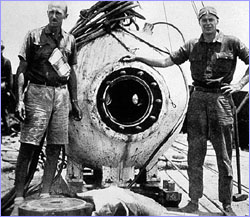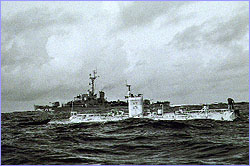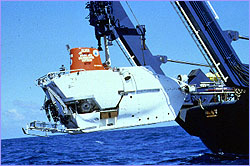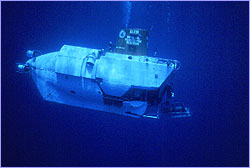
|
 |
 |
 Deep-Sea Machines
Deep-Sea Machinesby Jennifer Uscher Bathysphere The bathysphere—bathys is Greek for "deep"—was developed in the early 1930s by William Beebe and Otis Barton, two explorers from the New York Zoological Society. It was a 4,500-pound hollow steel ball about five feet in diameter,which was raised and lowered from a ship by a cable. Electrical connections powered its oxygen system and searchlight. Air came from oxygen tanks fitted to the interior, with trays of powdered chemicals to absorb moisture and carbon dioxide. The oxygen was kept circulating by hand-held woven palm-frond fans. In 1934, Beebe and Barton dropped 3,028 feet down into the ocean off the coast of Bermuda, relaying news of their finds by telephone cable to a ship on the surface. They recorded every animal that passed before their portholes, including fish and invertebrates never before seen. Because of the attached steel cable and winch, the bathysphere wasn't very maneuverable; it could only go straight down and straight back up again.  Bathyscaph
BathyscaphThe bathyscaph, designed by Belgian scientist Auguste Piccard (1884-1962), was not suspended from a surface vessel but rather attached to a free-floating tank. (The tank was filled with petroleum liquid, which is lighter than water and hence buoyant.) Piccard's first bathyscaph, the FNRS-2, was referred to as the "submarine balloon" because its heavy-metal ballast, attached by electromagnets, allowed it to sink to a desired depth when engaged and rise to the surface when released. It had greater maneuverability than the bathysphere,  though it did not fare well in tests. Piccard and his son
Jacques later designed and built a new bathyscaph, the
Trieste. In 1953, they descended in it to a depth of 10,330
feet in the Mediterranean. The Piccards sold the Trieste to
the U.S. Navy in 1958. On January 23, 1960, the Trieste set a
new world record of 35,800 feet when it touched bottom in the
Marianas Trench near Guam. When the American submarine
Thresher sank off the coast of New England in 1963, the
Trieste was used to find and photograph the remains at the
bottom of the sea.
though it did not fare well in tests. Piccard and his son
Jacques later designed and built a new bathyscaph, the
Trieste. In 1953, they descended in it to a depth of 10,330
feet in the Mediterranean. The Piccards sold the Trieste to
the U.S. Navy in 1958. On January 23, 1960, the Trieste set a
new world record of 35,800 feet when it touched bottom in the
Marianas Trench near Guam. When the American submarine
Thresher sank off the coast of New England in 1963, the
Trieste was used to find and photograph the remains at the
bottom of the sea. Alvin
AlvinThe Alvin submersible is operated by the Woods Hole Oceanographic Institution on Cape Cod, Massachusetts. Considered the world's most productive submersible, it routinely makes more than 150 dives a year. It has been re-built numerous times since it was first designed in 1964. The original aluminum frame has been replaced by titanium, and the depth range has been increased from 13,124 feet to 14,764 feet. In 1966, Alvin, together with a Navy robot, retrieved a hydrogen bomb lost in the Mediterranean after the collision of an American B-52  and a refueling tanker. During preparations for a dive off
Cape Cod in 1968, the steel cables used to raise and lower
Alvin into the water snapped, sending it 5,065 feet to the
seafloor (fortunately with no one on board). When it was
retrieved 11 months later, scientists were stunned to find
that the bologna sandwich contained in a plastic box in the
sunken submersible was still edible.
and a refueling tanker. During preparations for a dive off
Cape Cod in 1968, the steel cables used to raise and lower
Alvin into the water snapped, sending it 5,065 feet to the
seafloor (fortunately with no one on board). When it was
retrieved 11 months later, scientists were stunned to find
that the bologna sandwich contained in a plastic box in the
sunken submersible was still edible.
Continue: Johnson Sea Link The Mission | Life in the Abyss | The Last Frontier | Dispatches E-mail | Resources | Table of Contents | Abyss Home Editor's Picks | Previous Sites | Join Us/E-mail | TV/Web Schedule About NOVA | Teachers | Site Map | Shop | Jobs | Search | To print PBS Online | NOVA Online | WGBH © | Updated October 2000 |